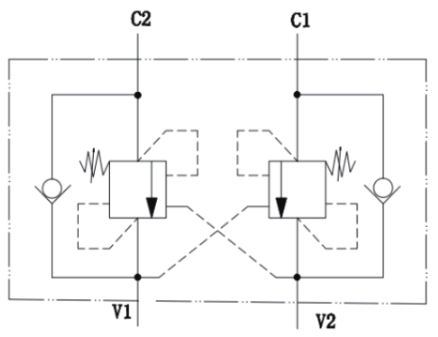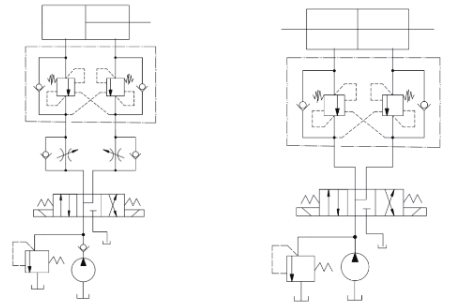
Analysis and Application of DOUBLE COUNTERBALANCE VALVE
2024-02-20The working conditions of engineering machinery are complex. In order to avoid stalling or overspeeding in the hydraulic transmission system, balance valves are often used to solve this problem. However, frequency supply vibration will occur during load operation, and it cannot solve the problem of reciprocating or rotating motion. stalling and overspeeding issues. Therefore, this article introduces a two-way balancing valve to improve the shortcomings of the balancing valve.
1.Working principle of two-way balancing valve
The two-way balancing valve is composed of a pair of identical balancing valves connected in parallel. The graphic symbol is as shown in Figure 1. The control oil port is connected to the oil inlet of the branch on the other side. The two-way balancing valve is composed of a main valve core, a one-way valve sleeve, a main mesh core spring and a one-way valve spring. The throttling control port is composed of the main valve core of the balance valve and the one-way valve sleeve.

Figure 1:Graphical symbol of a two-way balancing valve
The two-way balancing valve mainly has two functions: hydraulic lock function and dynamic balancing function. The working principle of these two functions is mainly analyzed.
Dynamic balance function: Assuming that the pressure oil flows from CI to the actuator, the pressure oil overcomes the spring force of the one-way valve in this branch, causing the throttle valve control port to open, and the pressure oil flows to the actuator.
The return oil acts on the main valve core of this branch from C2, and together with the pressure oil in the control port, drives the movement of the main valve core. Due to the elastic force of the main valve core, the oil return chamber of the actuator has back pressure, thereby ensuring smooth movement of the actuator. When the pressure oil flows from C2 to the actuator, the check valve at C2 and the main valve core at C1 move (at first, the working principle is the same as above).
Hydraulic lock function: When VI and V2 are at zero pressure, the oil pressure at the control port of the two-way balance valve is very small, approximately OMPa. The oil pressure in the actuator and the actuator cannot overcome the spring force of the main valve core, so the valve core cannot move, and the one-way valve has no shallow conduction, and the throttle valve control port is in a closed state. The two controls of the actuator are closed and can stay in any position.
2.Engineering examples of two-way balancing valves
Through the above analysis, the two-way balance valve not only makes the hydraulic actuator move smoothly, but also has the performance of hydraulic lock, so it is widely used. This article mainly introduces specific engineering examples of heavy load and reciprocating motion.
The application of the hydraulic principle in the main girder legs of the high-speed railway bridge erecting machine is shown in Figure 3. The main girder legs of the high-speed railway bridge erecting machine are at rest. It supports not only the vehicle volume of the bridge erecting machine itself, but also the volume of concrete beams. The load is large and the support time is long. At this time, the hydraulic locking function of the two-way balance valve is used. When the bridge erecting machine moves up and down, due to the large vehicle volume, it needs to move smoothly. At this time, the dynamic balance of the two-way balance valve is used. There is also a one-way throttle valve in the system, which increases the back pressure of the actuator, further improving the Movement stability.

Figure 2 The main beam legs of the high-speed railway bridge erecting machine Figure 3 The boom of the aerial work platform
In the application of booms on aerial work platforms, the hydraulic schematic diagram is shown in Figure 3 [3]. When the luffing angle of the boom increases or decreases, the movement is required to be smooth, and the two-way balance valve prevents stalling or overspeeding during its reciprocating motion. A certain danger arises.
3.Section
This article mainly analyzes the working principle analysis and practical engineering application of the two-way balance valve from the hydraulic lock function and dynamic balance function, and has a deep understanding of the two-way balance valve. It has certain reference for its development and application.




